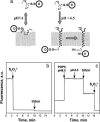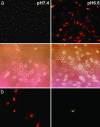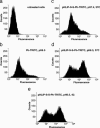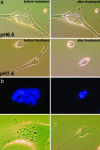Translocation of molecules into cells by pH-dependent insertion of a transmembrane helix
- PMID: 16608910
- PMCID: PMC1435408
- DOI: 10.1073/pnas.0601463103
Translocation of molecules into cells by pH-dependent insertion of a transmembrane helix
Abstract
We have previously observed the spontaneous, pH-dependent insertion of a water-soluble peptide to form a helix across lipid bilayers [Hunt, J. F., Rath, P., Rothschild, K. J. & Engelman, D. M. (1997) Biochemistry 36, 15177-15192]. We now use a related peptide, pH (low) insertion peptide, to translocate cargo molecules attached to its C terminus across the plasma membranes of living cells. Translocation is selective for low pH, and various types of cargo molecules attached by disulfides can be released by reduction in the cytoplasm, including peptide nucleic acids, a cyclic peptide (phalloidin), and organic compounds. Because a high extracellular acidity is characteristic of a variety of pathological conditions (such as tumors, infarcts, stroke-afflicted tissue, atherosclerotic lesions, sites of inflammation or infection, or damaged tissue resulting from trauma) or might be created artificially, pH (low) insertion peptide may prove a useful tool for selective delivery of agents for drug therapy, diagnostic imaging, genetic control, or cell regulation.
Conflict of interest statement
Conflict of interest statement: No conflicts declared.
Figures






References
-
- Krogh A., Larsson B., von Heijne G., Sonnhammer E. L. J. Mol. Biol. 2001;305:567–580. - PubMed
-
- Lehnert U., Xia Y., Royce T. E., Goh C. S., Liu Y., Senes A., Yu H., Zhang Z. L., Engelman D. M., Gerstein M. Q. Rev. Biophys. 2004;37:121–146. - PubMed
-
- Popot J.-L., Engelman D. M. Biochemistry. 1990;29:4031–4037. - PubMed
-
- Engelman D. M., Chen Y., Chin C. N., Curran A. R., Dixon A. M., Dupuy A. D., Lee A. S., Lehnert U., Matthews E. E., Reshetnyak Y. K., et al. FEBS Lett. 2003;555:122–125. - PubMed
-
- Van den Berg B., Clemons W. M., Jr., Collinson I., Modis Y., Hartmann E., Harrison S. C., Rapoport T. A. Nature. 2004;427:36–44. - PubMed
Publication types
MeSH terms
Substances
Grants and funding
LinkOut - more resources
Full Text Sources
Other Literature Sources

